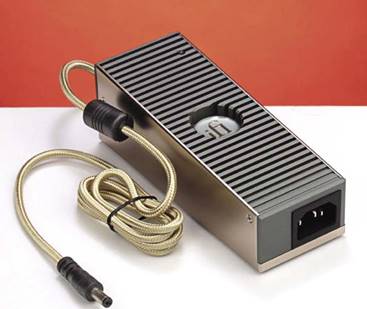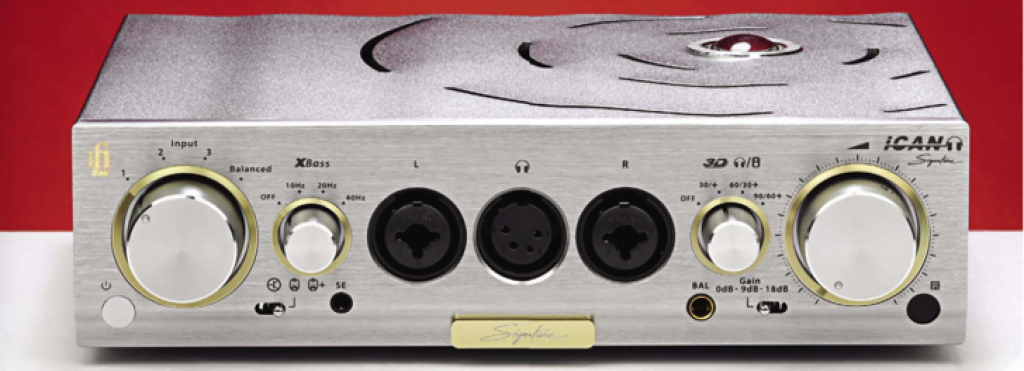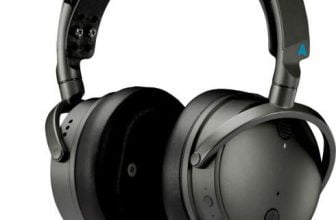IFI PRO ICAN SIGNATURE Review: iCan? uCan!
iFi’s unusual but sophisticated Pro iCan headphone amp gets an ‘Signature’ uplift. Martin Pipe reports. Read our IFI PRO ICAN SIGNATURE Review.
Of the serious headphone amps currently vying for your attention, one of the latest is the ‘Signature’ version of the significantly-sized and eyecatchingly-busy Pro iCAN from iFi – a firm better known for producing bijoux hip-flask sized headphone amps, DACs, phono stages and Bluetooth receivers. Key to that Signature suffix is the inclusion – as standard – of a ‘iPower Elite’ audiophile power supply.This 15V DC, 3.5A device – described as (electrically) “quiet as a battery” but with “none of the hassle” – is available separately to existing Pro iCAN owners, should they wish to upgrade.
There is however more to the Signature than a fancy power brick. Lurking within are, relative to the original Pro iCAN, more “ultragrade audiophile components” intended to “take your listening to a higher plane than ever before”. To leave you in no doubt, the Signature’s front panel is finished with gold trim and a badge that proclaims its elevated status.
Describing the Pro iCan Signature as a mere ‘headphone amp’ would be a bit like calling the current HMS Queen Elizabeth ‘a boat’. There are no fewer than five headphone sockets on its front panel. In addition to a standard 3.5mm stereo jack for conventional headphones, there are 4-pin XLR and 4.4mm four-pole (tip/ring/ring/ sleeve) sockets for balanced ‘phones. The remaining two are a pair of 6.3mm stereo jacks on either side of the XLR, for iFi’s proprietary SEC (‘Single-Ended Compatible’) balanced system. A special lead is needed to connect balanced ‘phones to these. SEC’s advantage is that standard unbalanced headphones can be plugged into the right-hand jack.
A sixth rear-panel output is intended for a proprietary ‘iESL Electrostatic Headphone Energiser’. The choice of a HDMI-type connector for proprietary hardware was probably not iFi’s most sensible design decision. However, there’s more to the Pro iCan Signature than headphones. It can also be used as a high-end preamplifier, the volume-controlled output simultaneously being available on XLR and phono outputs.These could feed power amps or active speakers – such as the Adam A5s I successfully tried.
To take full advantage of such functionality, users can attach four line-level sources (three unbalanced phono, one balanced XLR) to rear-panel connectors.These are selected via a large knob, located on the opposite end of the front panel to the similarly-sized volume control. Next to the source selector is the four-position ‘XBass’ switch, which provides four levels of careful bass boost to compensate for ‘different recordings and headphones’. As well as ‘bypass’, there are rolloffs at 10Hz (which few hi-fi grade transducers will reach), 20Hz (some models) and 40Hz (more!). iFi emphasises that XBass is not a ‘gimmick to add artificial bass’. Hinting at more unusual signal processing is the control’s front-panel counterpart, ‘3D Holographic’. Implemented totally in the analogue domain with passive components, according to iFi, this headphone-only processing offers three steps of signal ‘matrixing’ to make the headphone experience subjectively more like speaker listening (i.e. reduce the ‘hole in the middle’ effect).Three steps – 30 degrees (corresponding to ‘narrow’ speaker placement), 60 degrees (‘textbook’ placement) and 90 degrees (‘wide’) are available, as well as a relay-switched bypass.
Other switches select 9dB or 18dB of gain to accommodate less- sensitive headphones, or the driver stage that feeds the headphone amps and line outputs. Here you’re given a choice of solid-state (JFET- based circuitry) or tubes working in two modes, one of which relies on minimal negative feedback.
Tubes? Yes indeed…two of ‘em, in fact, glowing upwards at you from a circular window set into the top of the unit.They are ‘new old stock’ (NOS) GE-made JAN 5670s – miniature double-triodes originally intended to work at VHF radio frequencies. Several years ago, iFi’s parent company AMR snapped up a stockpile of these military-spec valves – which it prefers on account of their sound quality, claimed to approach that of the legendary Western Electric WE396A – to meet its needs ‘for the foreseeable future’.You’ll find 5670s in some other iFi/AMR designs, including the regular version of the Pro iCan. They’re not particularly uncommon, but NOS valves like that specific GE model are, by their very nature, finite in supply (production ended in the 1980s).They are larger, and pin-incompatible, with better-known double-triodes like the ECC83/I2AX7. It’s perhaps just as well that their lives can be measured in the tens of thousands of hours if operated correctly; for the Pro iCan Signature, though, iFi merely quotes ‘many years of enjoyment’.

The only remote operation is control over volume; selecting sources, for example, can only be performed by a front-panel knob.
The handset’s other buttons operate various functions of iFi’s companion Pro iDSD DAC.
USE AND SOUND QUALITY
Inside, the circuitry is built on high-quality printed circuit boards to computer-like standards.The MOSFET-buffered bipolar Class- A final output stages mounted on them, which will operate in Class A/B at high levels, are incredibly-potent by headphoneamp standards. iFi claims that distortion-free peaks of 14 watts into balanced loads (4.8W into unbalanced ones) are possible. I was able to simultaneously-drive three pairs of headphones – Meze Empyrean (6.3mm), Hifiman Sundara (3.5mm) and Focal Utopia with Atlas balanced cable (XLR) – with no audible strain whatsoever.

It may look like a computer motherboard, but this complex but orderly construction actually lives within the Pro iCAN Signature’s distinctive enclosure. We can also see the output stage heatsinks, motorised ALPS volume control and two horizontallymounted ‘new old stock’ GE- made 5670 miniature doubletriodes.

Gold trim and a ‘Signature’ badge distinguish this version from the regular Pro iCan. You get the original’s features but there are internal component-related differences.
My final trick here was to wire up a pair of loudspeakers (Wharfedale Diamonds) directly. Good clean listening levels, in a smallish room, were obtained here too! I sincerely doubt that the Pro iCan Signature will have any trouble with less-sensitive ‘phones like the Dan Clark Stealth planar magnetics.The circuitry is fully- balanced, with identical circuitry for both signal phases of each channel. To this end the motorised volume pot (remote-controllable, with the supplied handset) is more complex than most. It’s an ALPS type with six sections, four of which look after the balanced signals. No wonder iFi recommends using balanced headphones whenever possible, as they will be able to “take full advantage of the Pro iCan Signature’s true balanced nature”.
Unfortunately, plugging in headphones doesn’t mute the line input. If you’re using the Pro iCan Signature as a preamp, you’ll have to switch off your power amps before listening with headphones. Its good to see that iFi has muted switching functions – the gain switch and tube/solid-state mode, for example – to avoid ‘pops’. An iFi logo on the front panel is white-backlit if you’re listening via a signal path that’s totally solid-state, or orange if tubes are included. Said logo flashes for a few seconds if the valve has to warm up – there’s then a brief silence, as the relevant electronics is switched in.

Key to that Signature suffix is the inclusion of this device. It’s a 15V DC, 3.5A ‘iPower Elite’ audiophile power supply, described by iFi as “quiet as a battery” but with “none of the hassle”. Existing Pro iCAN owners can buy one as a £ upgrade.
At another practical level, turning the small XBass and ‘3D Holographic’ knobs can be a bit fiddly if headphones are plugged into the adjacent 6.3mm jacks. On the whole, though, the Pro iCan Signature is a well thought-out design. Even the base on which the cabinet sits has received attention – it has been ‘quad damped’! I did however note an odd effect with the review sample. Plugging balanced phones into the XLR socket significantly raises the volume level of any headphones connected to the right-hand 6.3mm jack – unless the gain switch is in its 9dB or 18dB position.The 3.5mm unbalanced output is unaffected.
I tried a number of sources with the Pro iCan Signature, but most of my listening revolved around a Naim Uniti Atom Headphone Edition connected via its balanced output. The overall impression I get from listening to the Pro iCan Signature is one of clarity, authority and scale – the latter quality eclipsing even the Naim’s fine headphone amp! At no time was any sign of strain audible, and even with the valves switched into circuit the unit is extremely quiet. With dynamic symphonic recordings – Carl Orff’s Carmina Burana (Orchestra Salzburg Mozarteum/Kurt Prestel) and Stravinsky’s Rite of Spring (Birmingham S.O./Simon Rattle), for example – it could swing from forte passages to the most delicate, with no impact on the subtlest of details. How Did This Happen, by New Yorkers Bodego, was heard with tight bass, decent imaging and plenty of drive and rhythm. I also revelled in the percussive detail revealed in One Man No City, by fellow American ‘indies’ Parquet Courts.

iFi has bundled this phono- to-phono cable, with gold- plated contacts, to get you going.
All of this was in the unit’s default mode (solid-state, all processing turned off), and even here imaging was wide and tonality neutral. XBass was surprisingly effective, adding impact without overblowing low frequencies or adding colouration elsewhere.A track like London Grammar’s Hey Now demonstrated it well, certainly with the Utopias. iFi recommends using the gain switch only if necessary, and indeed I found that the most open sound was conveyed when it was turned off.

Four inputs – three unbalanced sets of phonos, and a pair of XLRs – demonstrate that iFi is serious about the Pro iCAN Signature serving as a preamp, as well as a sophisticated ‘headphone hub’. External amps can be fed via unbalanced or balanced outputs. That HDMI-like connector is reserved for a proprietary ‘iESL Electrostatic Headphone Energiser’.
Switching to valves resulted in a smoother and warmer presentation, harder edges being rounded off. 3D Holographic was interesting, notably altering the width of the image, and can benefit some recordings. Users will doubtless have plenty of fun experimenting with these features, to determine what works best with their particular headphones and music.
CONCLUSION
The Pro iCan Signature is hardly a minimalist headphone amp. iFi’s engineers have however designed the numerous features, which can be of value, so that they add minimal degradation. In any case, they can be bypassed if not required. In terms of performance, you get a big and engaging sound – backed by plenty of output power that will accommodate the least sensitive of headphones, or drive several pairs simultaneously.We should not overlook the Pro iCan Signature’s ability to act as a four- input preamp. It could therefore be at the heart of a hi-fi system built around speakers rather than headphones, rather than merely sitting on the periphery.
MEASURED PERFORMANCE
This is a fully balanced preamplifier internally with balanced XLR inputs and outputs at rear, plus alternative singleended inputs and outputs, phono sockets and 3.5mm stereo jack socket.
The front balanced outputs for headphones are via a 4.4mm 4pole jack socket (not a Pentaconn that is five pole), a 4pin XLR socket and two standard 1/4in (6.3mm) 3pole headphone jack sockets that need special cabling for tips and rings to deliver a balanced signal – an unusual arrangement. The front balanced outputs delivered the same measured results as the rears.
Maximum balanced output measured 20V (from solid-state and valve input) and gain was switchable to deliver 8.6V, 2.9V or 1V from 1V input, corresponding to gains of 18dB, 9dB and 0dB as claimed. Unbalanced output was 10V from the rear phono sockets and front 3.5mm stereo jack socket.
Frequency response stretched from 1Hz to 70kHz (-1dB) at half volume, changing little at full and low volume. Distortion was extremely low at 0.002% with solid-state or valve (tube) selected.
The iFi Pro iCAN Signature measured very well in all areas. It has massive output, more than enough to drive all headphones.

OUTSTANDING – amongst the best.
VERDICT
iFi


